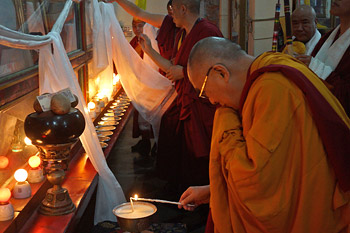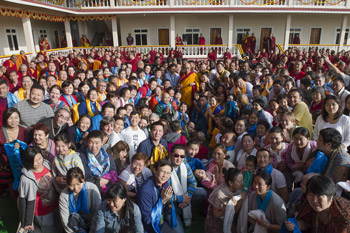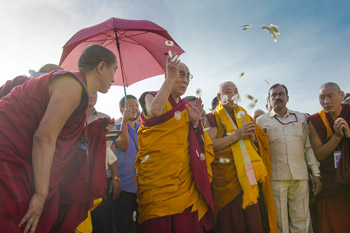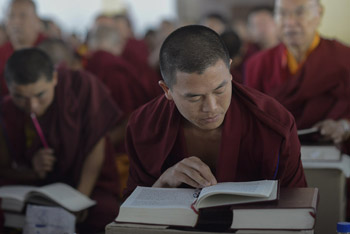Third Day of Lam Rim Teachings at Ganden Jangtse Monastery
26/12/2014 17:41 (GMT+7) Font size:  
Mundgod, Karnataka, India, 25 December 2014 - Invited to inaugurate the new Drepung Gomang Mongolian Students' Hostel at that other end of the Mundgod Tibetan Settlement, His Holiness the Dalai Lama drove out of the Ganden Jangtse compound early this morning. He made a couple of other visits on the way. 
| His Holiness the Dalai Lama lighting a butter lamp during his visit to Ganden Lachi in Mundgod, Karnataka, India on December 25, 2014. Photo/Jeremy Russell/OHHDL
|
First stop was the Ganden Lachi, where he was received by the incumbent Abbots. He inspected and paid his respects before the various images enshrined in the temple and lit a butter lamp in front of them. In the protector chapel a new breastplate was offered to the statue of Dharmaraja, traditionally the protector of Je Tsongkhapa’s doctrine.
Next stop was the Drepung Lachi. Monks and lay-people, young and old, lined the road to see His Holiness pass. He visited the temple, again inspecting and paying respects before the images enshrined there, before visiting the protector chapel and offering brief prayers. Reaching the new hostel for Mongolian students he unveiled a commemorative plaque and took his seat on the veranda. There are currently nearly 400 students at Gomang from the various Mongolian regions, including Inner Mongolia, and the hostel is expected to accommodate nearly 200 of them. Addressing the assembly of monks and lay-people he said:
“We Tibetans became refugees, while you Mongolians regained your independence. Since we had re-established learning institutions in our refugee settlements, once you were free to do so, you were able to come here to study. Like Tibet, yours is a traditionally Buddhist country and during the Communist era you maintained your faith, so you were able to revive it again after your independence was restored. In the presence of the Mongolian Ambassador, the sponsors and parents of the monks, I am happy to be able to inaugurate this new hostel. My greetings to you all.”

| His Holiness the Dalai Lama in front of the new Drepung Gomang Mongolian Students' Hostel in Mundgod, Karnataka, India on December 25, 2014. Photo/Tenzin Choejor/OHHDL
|
He said that both Tibet and the Mongolian regions maintain the Nalanda tradition, which involves rigorous study for more than 20 years. A key point is its use of logic and reasoning. At this point His Holiness was offered the traditional Mongolian delicacy of a bowl of horse milk, which he drank with a broad smile. He mentioned a sutra that predicted that the Buddha’s teaching would go from north to north. Some have interpreted the first north as indicating Tibet and the second as Mongolia. In Tibet, there were Mongolian students in Tashi Kyil and Kumbum as well as at the Three Seats and Tashi Lhunpo, nearly all of whom engaged diligently in study. He mentioned several names and recalled the best of his own debating assistants, a scholar called Ngodrup Choknyi, who was dedicated to the Madhyamaka view and was very helpful to His Holiness.
“Among the world’s religious traditions, Buddhism is distinct for its use of logical investigation,” His Holiness said. “The Nalanda tradition seems to be the most comprehensive presentation of the Buddha’s teachings available today. It incorporates knowledge of the mind and emotions that is not only of use to Mongolians and Tibetans, but is of potential benefit to all humanity, which is why many scientists are taking interest in it. However, the only way to preserve this tradition is through study and practice. You’ve come a long way to study here in India; work hard. I expect when you complete your studies some of you will stay to teach here, some of you will return home.”

| His Holiness the Dalai Lama inaugurating Yelo Rinpoche's new meditation center in Mundgod, Karnataka, India on December 25, 2014. Photo/Tenzin Choejor/OHHDL
|
Not far from the Mongolian Students’ Hostel His Holiness inaugurated a meditation centre established by Yelo Rinpoche, a Gomang Incarnate Lama. He is a resident Buddhist teacher in Ulan-Ude, capital of Buryatia, one of the Mongolian Republics of the Russian Federation. His Holiness cut the ribbon and visited the library.
Back at Ganden Jangtse Monastery, His Holiness resumed his reading of ‘Liberation in the Palm of Your Hand’. He said:
“There is a custom of reciting a praise to the Buddha before beginning to teach that I have borrowed from Khunu Lama Rinpoche. He used to spontaneously recite different verses, which I am unable to do. I can only recite the introductory verse of homage from Nagarjuna’s ‘Fundamental Wisdom’, which I also say as soon as I wake up, or sometimes when I’m unable to sleep.”
I prostrate to the Perfect Buddha,
The best of teachers, who taught that
Whatever is dependently arisen is
Unceasing, unborn,
Unannihilated, not permanent,
Not coming, not going,
Without distinction, without identity,
And free from conceptual construction.
The LamRim text dealt with advice for day to day practice, preparatory rites such as cleaning the room, setting up an altar, arranging offerings and adjusting the body and motivation. His Holiness remarked that the three trainings in ethics, concentration and wisdom can be found in other spiritual traditions, particularly those originating in India. When the three trainings are observed in Buddhism, qualified by an understanding of emptiness, they are known as the Three Higher Trainings. He advised that Buddhists need to practice for a long time and to be determined persist for as long as it takes. He said this means being practical and realistic.

| Monks following the texts during the third day of His Holiness the Dalai Lama's teachings at Ganden Jangtse Monastery in Mundgod, Karnataka, India on December 25, 2014.
Photo/Tenzin Choejor/OHHDL
|
Returning after lunch, looking in the direction of the Westerners, His Holiness beamed and wished them a ‘Merry Christmas’ teasing them that they must be missing their big dinner. He continued to read from ‘Liberation in the Palm of Your Hand’. He said that to imagine that there is a magical instruction apart from what is contained in the classic texts is an error. Je Tsongkhapa says there is no other instruction. What we have to do is study what the classic texts say and implement that into the path. That is the real magic that moves the heart.
“Here in the three great monasteries you study for 20 years or more, but there is no secret instruction other than what you study in the classic scriptures. In the last century there was a great practitioner of Chö, who attracted many followers. When this began to affect the Three Seats, Thongpön Rinpoche was very critical. Subsequently the 13th Dalai Lama instituted a stricter system of examination and selection procedures for the Gelugpa hierarchs. Ganden Tripa Yeshi Wangdu was one of the first to be elevated in the new system.”
His Holiness mentioned that Je Rinpoche, Tsongkhapa, made reference consistently to the original sources; the Indian texts. He said that he has paid tribute to this in the prayer he composed in praise of the 17 Masters of Nalanda. He remarked that although it is established practice to invoke the 16 Arhats, the 17 Mahapanditas’ contribution has been much more directly effective. Their writings help us understand the two truths, as His Holiness has written. He said:
“We are the heirs of the Nalanda tradition and it is you, studying here in these monasteries now, who will carry on this tradition. If the tradition declines here, it will disappear altogether.”
Tomorrow, in addition to the teachings’ continuing, there will a ceremony to mark the 55th anniversary of the first teaching His Holiness gave in India and he will be offered a Long-Life prayer.  http://www.dalailama.com/
|